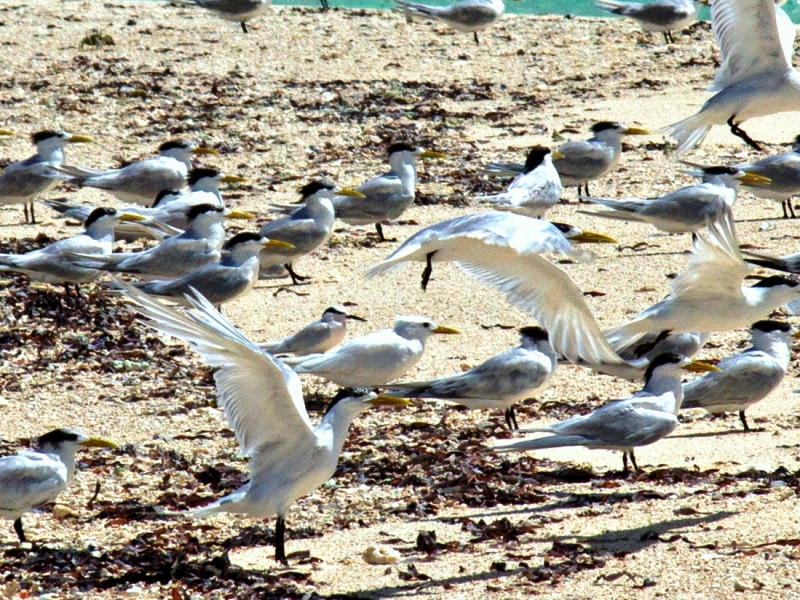Birds of a feather |22 December 2014
Twice in recent weeks I have received surprising photos of very familiar birds in very unfamiliar plumage. The first came from Island Conservation Society staff Aurelie Duhec and Richard Jeanne at the recently opened conservation centre on Farquhar. They sent a photo showing a pure white Great Crested Tern (or Golan Sardin in Creole). This was seen at Farquhar amid a flock of normally coloured birds.
I emailed a copy of this photo to Hein Van Grouw, a Dutch expert in bird colour aberrations, based at the British Natural History Museum. He replied to say this was not an albino as the bill and the feet are more or less normally coloured (and albinos do not survive well in the wild due to poor eyesight). It was an individual with a pigmentation mutation that made it very light sensitive so that the plumage has bleached rapidly in the strong sunlight of Seychelles.
The second surprise came courtesy of Glacis resident Alexandra Azais who emailed a photo of a spectacular white-winged male Madagascar Fody or Tisren.
Alexandra wrote eloquently and passionately about her flock of fodies with which she shares her little corner of Glacis and so with her permission I quote her words directly:
“Like many people in the Seychelles I take great pleasure in feeding rice to these cute little birds. I usually do this twice a day, sharing breakfast at 6am and again at 4pm. They are very punctual. They expect me to conduct myself well and if I tarry too long they remain patiently perched on the finer branches of the star fruit tree I have in front of the veranda preening themselves.
“There are family groups of about twenty individuals with the head of each clan usually acting very aggressively towards other clan leaders. All together there are more than 500 birds. Their livery changes with the seasons and at Christmas males are at their most flamboyant with little black joker masks contrasting with fiery red plumage. Females and young birds remain grey and sparrow-like throughout the year.
“Since 1999, when I arrived in Seychelles they have been my constant companions and I spend a considerable amount of time observing them. Three of them (always the same individuals, I suppose, since they are so easy to identify), are completely yellow, like canaries, two of these bright yellow, the third a little pale and present for about 15 years, which makes me think these birds live long lives! It was just last week that another member was added to the group, to my surprise and I noted immediately its resplendent white attire especially on the wings and back”.
The photo of this bird in flight clearly shows the strange but attractive plumage of this individual. This bird is what is known asleucistic. It lacks melanin pigment due to the cells responsible for melanin production being absent. Although leucism is inherited, the extent and positioning of the white colouration can vary.
Sometimes leucistic birds find it difficult to find a mate but when they do they can breed successfully like any other red-blooded (or in this case red-plumaged!) male. Sometimes the leucism skips a generation. I do hope Alexandra’s bird finds a mate among her 500 or so flock. I find a white-winged Tisren somehow even more attractive than the standard variety!

Adrian Skerrett




